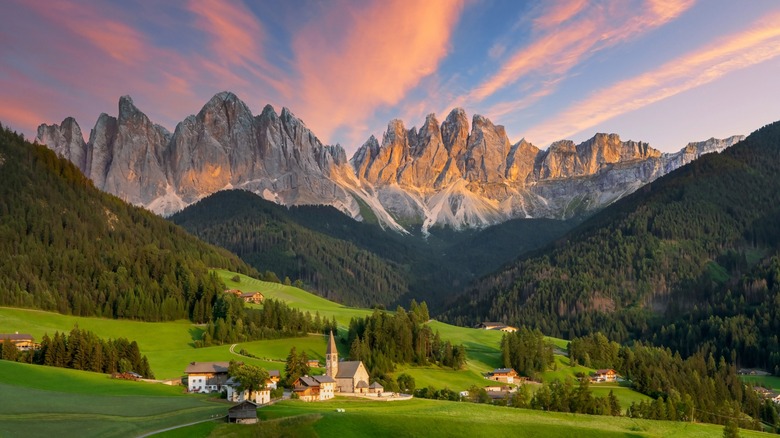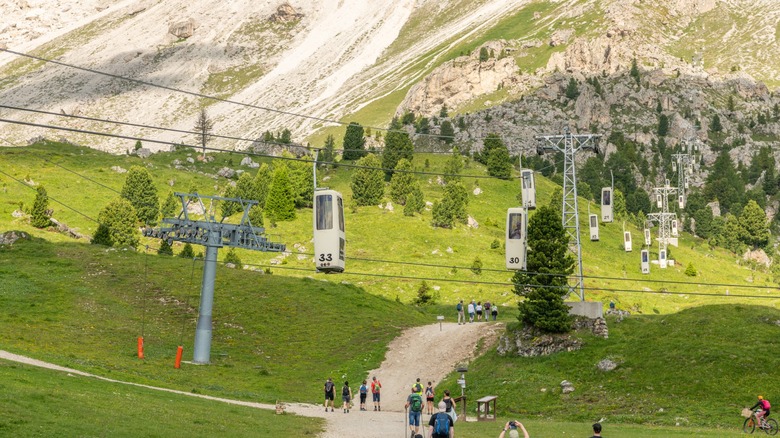
Not all gondola rides in Italy come with guides in striped shirts, sweet serenades, and Prosecco. This particular gondola doesn't glide along Venice's tranquil canals but soars to frightening heights in a standing-room-only cable car in the Dolomite Mountain section of the northern Alps. The cable car — or Telecabina Sassolungo— was likened to a flying telephone booth by a reviewer on TripAdvisor. Indeed, each cabin's cramped quarters for two would give even Bill and Ted a run for their money. The cabins'
oblong shape somewhat resembles a coffin, but try not to think about that as you ascend.
There are plenty of hikes in the region, such as the trail to Lago di Sorapis with views of the Dolomite Mountains. Or, just as gorgeous, this hike to a breathtaking alpine meadow known as Alpe di Suisi. But why walk to your destination when you can fly there? Ascending at an exhilarating speed of 6.5 feet per second, the Telecabina Sassolungo climbs 1,600 feet toward the top of Sassolungo Mountain from the Sella Pass. Leaving behind the rolling green hills and meadows of Selva Val Gardena, the craggy, pale Dolomite mountain looms closer and rises from the earth like a towering castle.
The dramatic ride isn't for the faint of heart, but your stomach can finally stop churning once you reach the top and survey the unreal-looking, panoramic mountainscape and snowcapped mountains in the distance. The gondola's launch point in the village of Selva Val Gardena is as remote as it sounds, tucked in the northeastern corner of Italy, a three-hour drive north of Venice. Alternatively, you can take a direct flight from several major cities in Europe to the Bolzano International Airport, about an hour away from the Sella Pass.
Read more: European Destinations That Are Best To Visit In December
What Happens On The 'Coffin Gondola' Ride To Sassolungo Mountain

The Telecabina Sassolungo operates from mid-June through early October every day between 8:15 a.m. and 5 p.m. The ride gets zany right away, starting at the boarding platform. After paying around $29 to ascend (or $40 for the round trip), you have to get a running start and then jump into your "coffin" as it whizzes past. Thankfully, two operators are there to help you, and once you're in, they secure the door with a manual lock from the outside. But once you're inside, there's no turning back. The cabin is a tight squeeze with a two-person max, so that's something to consider if you're claustrophobic or wearing a backpack.
The hair-raising nature of the gondola ride with its exposure to the elements is kind of like riding a zipline, like the one in Pietrapertosa, a mountain town in southern Italy known for its thrilling adventures. On blustery days, the gondolas have been known to swing back and forth, and you can hear the wind howling through the pass. If the wind is too strong, rides on the lift are suspended until the gusts return to safe levels. Once you reach the top, though, the views of the endless peaks and deep valleys of the Dolomite Mountains are unreal.
The alpine experience pairs well with the menu at Rifugio Toni Demetz, which is perched near the end of the gondola ride at the top of the rocky pass. The restaurant features dishes like hearty stews, cured meats, red wine, and local cheeses, all of which are typical of traditional Tyrolean culture (think woodcarving, white knee socks, accordions, and yodeling). You can also book a stay at the rifugio. The 24 beds on offer are a choice between panorama rooms or a dormitory share, and breakfasts come with freshly brewed coffee or tea.
Ready to discover more hidden gems and expert travel tips? Subscribe to our free newsletter for access to the world's best-kept travel secrets.
Read the original article on Islands.











